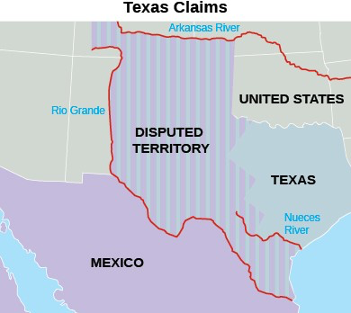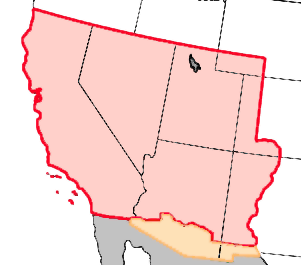Dalia Savy
Caleb Lagerwey
AP US History 🇺🇸
454 resourcesSee Units
Manifest Destiny goes south...but not too far south.
The Mexican-American War was a conflict between the United States and Mexico that took place between 1846 and 1848. The war was sparked by a dispute over the annexation of Texas by the United States and a long-standing dispute over the border between Texas and Mexico.
Context to the Mexican-American War
A preface to the Mexican-American War was the Texas War of Independence (1835-1836), a military conflict between the Republic of Texas (which was established by American settlers) and Mexico. The war ended with the decisive victory of the Texan army, led by Sam Houston, at the Battle of San Jacinto in April 1836. This resulted in the creation of the Republic of Texas, which was an independent nation for several years before it was annexed by the United States in 1845.
This war involved the Alamo and other famous battles like Goliad and San Jacinto that were part of period three, but let's quickly discuss them.
The Alamo is a key and iconic battle that took place during the Texan Revolution, where a small Texan army, mostly made of American settlers, was besieged by a larger Mexican army for 13 days. The defenders, which included famous figures like Davy Crockett, James Bowie, and William Barret Travis, were all killed by the Mexican army. The battle, despite the Texan defeat, became a symbol of Texan resistance and sacrifice and helped to inspire the Texan army to victory at San Jacinto.
The Goliad Campaign was a series of events that took place in March 1836 and it was led by General Santa Anna. He ordered his troops to execute more than 400 Texan prisoners, including the Commander and soldiers captured at the Battle of Coleto, who had been promised quarter, this event became known as the Goliad massacre. This event outraged many Texans and led them to fight more fiercely, leading to the defeat of the Mexican Army at San Jacinto.
The annexation of Texas by the United States in 1845 was a major point of contention between the two countries, and it was one of the main causes of the Mexican-American War, which began the following year.
Causes of the Mexican-American War
Here are the main causes of the Mexican-American War, in bullet form:
- Dispute over the border between Texas and Mexico. The U.S. claimed that the border was the Rio Grande, while Mexico insisted that it was the Nueces River.

Image Courtesy of Texas Higher Education Coordinating Board
- Annexation of Texas by the United States in 1845. Mexico had never recognized the independence of Texas and considered it to be a part of its territory.
- Expansionist policies of the U.S. government. Pro-expansionists were largely Democrats and had long eyed Mexico and other sub-tropical regions for their ability to grow crops that could lead to the expansion of slavery and the associated Southern way of life. Mexico seemed like a prime target. President James K. Polk was elected on a pro-expansion platform and sought to expand U.S. territory through Mexico.
- Economic and strategic interests. The U.S sought access to ports in Mexico and the California territory, with its vast resources and growing population.
In an effort to protect its claimed territory, the U.S. government under President James K. Polk ordered U.S. troops, under the command of General Zachary Taylor, to occupy land along the Rio Grande. This move was seen as a provocation by the Mexican government because of the dispute over the border, and the Mexican government responded by sending its own troops to the area.
The United States won after two years of battles and negotiations, and you can view them briefly on the map below. You do not have to know the specifics of the war itself, just the causes and effects of it!
The Treaty of Guadalupe Hidalgo
The Treaty of Guadalupe Hidalgo, signed on February 2, 1848, was a peace treaty between the United States and Mexico that officially ended the Mexican-American War.
Under the terms of the treaty, Mexico ceded a large portion of its territory to the United States, which we'll discuss below. Mexico was also compensated with $15 million and the U.S. assumed responsibility for the claims of American citizens against Mexico.
The treaty also included several provisions related to the rights of Mexican citizens living in the ceded territory. These provisions guaranteed them the right to remain in the territory and become U.S. citizens, to continue to practice their Catholic religion, and to retain their property rights. However, these rights were not fully respected and enforced, and in the following years, many Mexicans living in the ceded territory faced discrimination, violence, and the loss of their land.
Effects of the Mexican-American War
The Mexican-American War was an important event as it serves as a link between Manifest Destiny and the Civil War: it is a great example of how Westward expansion led to increasingly bitter and divisive debates over slavery in new territories.
The Mexican-American War had a number of significant effects on both the United States and Mexico. Some of the most notable effects include:
- Territorial changes: Mexico ceded a large portion of its territory to the United States, including present-day California, Nevada, Utah, Arizona, New Mexico, and parts of Colorado, Wyoming, Kansas, and Oklahoma. This loss of territory had a profound impact on Mexico and its people, and it is still a sensitive topic in Mexico to this day. The land that was lost to the United States was known as the Mexican Cession.

The Mexican Cession, shown in red, and the later Gadsden Purchase, shown in yellow; Image Courtesy of Matthew Trump on Wikimedia
- Economic and political effects: The war had an impact on the economy of both countries. The U.S. acquired new territory and resources, and the war led to economic growth and expansion in the West. On the other hand, Mexico experienced a loss of territory, resources, and population and significant debt. The war also led to the rise of political factions in Mexico and contributed to the instability of the country's political landscape in the decades that followed.
- Slavery and race relations: The war had an impact on the issue of slavery in the United States. The acquisition of new territory and the question of whether or not to allow slavery in those territories became a major point of contention between the Northern and Southern states, which ultimately helped to fuel the growing divide between the two regions and contributed to the eventual outbreak of the American Civil War.
- Impact on Native Americans: The war and the subsequent U.S. expansion led to the displacement and forced relocation of many indigenous people, which had a significant impact on their communities and cultures.
- Relations with Mexico: The war left bitterness and mistrust between the two countries, the U.S. annexation of Texas and the treatment of Mexico during the war caused many Mexicans to view the U.S. as an imperialistic and aggressive neighbor.
The Wilmot Proviso
The Wilmot Proviso was an unsuccessful addition to a bill to fund the US army during the war. It argued for a complete ban on slavery in captured territories, which, of course, only made tensions worse. It passed the House of Representatives—hello, Northern population advantage!—but failed in the Senate.
This showcased the necessity for Southerners to keep the balance of states in the Senate as their population totals fell behind those of the North: the Senate, which is equal representation for each state regardless of population, was the safeguard for the South’s interests as the North continued to add to its population advantage in the House and Electoral College.
The Wilmot Proviso was the first time congressional action was taken with the intent of limiting the expansion of slavery.
Browse Study Guides By Unit
🌽Unit 1 – Interactions North America, 1491-1607
🦃Unit 2 – Colonial Society, 1607-1754
🔫Unit 3 – Conflict & American Independence, 1754-1800
🐎Unit 4 – American Expansion, 1800-1848
💣Unit 5 – Civil War & Reconstruction, 1848-1877
🚂Unit 6 – Industrialization & the Gilded Age, 1865-1898
🌎Unit 7 – Conflict in the Early 20th Century, 1890-1945
🥶Unit 8 – The Postwar Period & Cold War, 1945-1980
📲Unit 9 – Entering Into the 21st Century, 1980-Present
📚Study Tools
🤔Exam Skills
👉🏼Subject Guides
📚AMSCO Notes

Fiveable
Resources
© 2025 Fiveable Inc. All rights reserved.